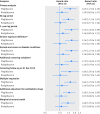Pioglitazone use and risk of bladder cancer: population based cohort study
- PMID: 27029385
- PMCID: PMC4816602
- DOI: 10.1136/bmj.i1541
Pioglitazone use and risk of bladder cancer: population based cohort study
Abstract
Objective: To determine whether pioglitazone compared with other antidiabetic drugs is associated with an increased risk of bladder cancer in people with type 2 diabetes.
Design: Population based cohort study.
Setting: General practices contributing data to the United Kingdom Clinical Practice Research Datalink.
Participants: A cohort of 145,806 patients newly treated with antidiabetic drugs between 1 January 2000 and 31 July 2013, with follow-up until 31 July 2014.
Main outcome measures: The use of pioglitazone was treated as a time varying variable, with use lagged by one year for latency purposes. Cox proportional hazards models were used to estimate adjusted hazard ratios with 95% confidence intervals of incident bladder cancer associated with pioglitazone overall and by both cumulative duration of use and cumulative dose. Similar analyses were conducted for rosiglitazone, a thiazolidinedione not previously associated with an increased risk of bladder cancer.
Results: The cohort generated 689,616 person years of follow-up, during which 622 patients were newly diagnosed as having bladder cancer (crude incidence 90.2 per 100,000 person years). Compared with other antidiabetic drugs, pioglitazone was associated with an increased risk of bladder cancer (121.0 v 88.9 per 100,000 person years; hazard ratio 1.63, 95% confidence interval 1.22 to 2.19). Conversely, rosiglitazone was not associated with an increased risk of bladder cancer (86.2 v 88.9 per 100,000 person years; 1.10, 0.83 to 1.47). Duration-response and dose-response relations were observed for pioglitazone but not for rosiglitazone.
Conclusion: The results of this large population based study indicate that pioglitazone is associated with an increased risk of bladder cancer. The absence of an association with rosiglitazone suggests that the increased risk is drug specific and not a class effect.
Published by the BMJ Publishing Group Limited. For permission to use (where not already granted under a licence) please go to http://group.bmj.com/group/rights-licensing/permissions.
Conflict of interest statement
Competing interests: All authors have completed the ICMJE uniform disclosure form at
Figures


Comment in
-
Selecting the right drug treatment for adults with type 2 diabetes.BMJ. 2016 Mar 30;352:i1663. doi: 10.1136/bmj.i1663. BMJ. 2016. PMID: 27029501 No abstract available.
-
Don't dismiss pioglitazone on basis of uncertain risk.BMJ. 2016 Jul 6;354:i3667. doi: 10.1136/bmj.i3667. BMJ. 2016. PMID: 27384907 No abstract available.
References
-
- Kung J, Henry RR. Thiazolidinedione safety. Expert Opin Drug Saf 2012;11:565-79. 10.1517/14740338.2012.691963 pmid:22616948. - DOI - PubMed
-
- Dormandy JA, Charbonnel B, Eckland DJ, et al. PROactive Investigators. Secondary prevention of macrovascular events in patients with type 2 diabetes in the PROactive Study (PROspective pioglitAzone Clinical Trial In macroVascular Events): a randomised controlled trial. Lancet 2005;366:1279-89. 10.1016/S0140-6736(05)67528-9 pmid:16214598. - DOI - PubMed
-
- Turner RM, Kwok CS, Chen-Turner C, Maduakor CA, Singh S, Loke YK. Thiazolidinediones and associated risk of bladder cancer: a systematic review and meta-analysis. Br J Clin Pharmacol 2014;78:258-73.pmid:24325197. - PMC - PubMed
-
- Lewis JD, Ferrara A, Peng T, et al. Risk of bladder cancer among diabetic patients treated with pioglitazone: interim report of a longitudinal cohort study. Diabetes Care 2011;34:916-22. 10.2337/dc10-1068 pmid:21447663. - DOI - PMC - PubMed
-
- Neumann A, Weill A, Ricordeau P, Fagot JP, Alla F, Allemand H. Pioglitazone and risk of bladder cancer among diabetic patients in France: a population-based cohort study. Diabetologia 2012;55:1953-62. 10.1007/s00125-012-2538-9 pmid:22460763. - DOI - PMC - PubMed
Publication types
MeSH terms
Substances
Grants and funding
LinkOut - more resources
Full Text Sources
Other Literature Sources
Medical
